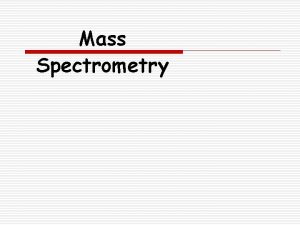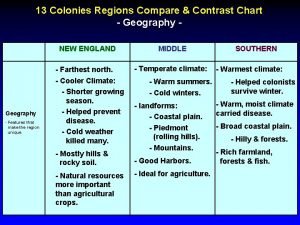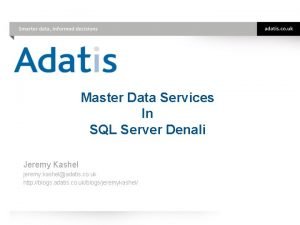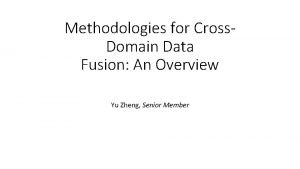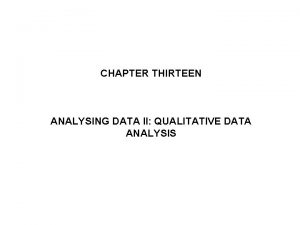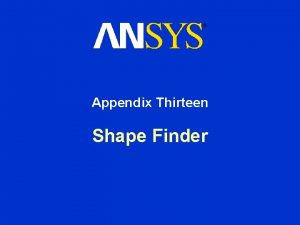Chapter Thirteen 13 1 Overview of the Data






























- Slides: 30

Chapter Thirteen 13 -1

Overview of the Data Analysis Procedure Validation & Editing Key Terms & Definitions Coding Data Entry Machine Tabulation & Cleaning Statistical of Data Analysis 13 -2

Overview of the Data Analysis Procedure Step One: • Validation: Process of ascertaining that interviews actually were conducted as specified. • Editing: Process of ascertaining that questionnaires were filled out properly and completely. • Skip Pattern: Sequence in which later questions are asked, based on a respondent’s answer to an earlier question or questions. Step Two: • Coding: Process of grouping and assigning numeric codes to the various responses to a question. Step Three: • Data Entry: Process of converting information to an electronic format. • Scanning: Form of data entry in which responses on questionnaires are read in automatically by the data entry device. Key Terms & Definitions 13 -3

Overview of the Data Analysis Procedure Step Four: • Clean the Data: Check for data entry errors or data entry inconsistencies. • Logical or Machine Cleaning: Final computerized error check of data. • Error Check Routines: Computer programs that accept instructions from the user to check for logical errors in the data. Step Five: • Data Analysis – e. g. , One-Way Frequency Tables: Table showing the number of respondents choosing each answer to a survey question. • Cross Tabulation Tables - Examination of the responses to one question relative to the responses to one or more other questions. Key Terms & Definitions 13 -4

Data Analysis Procedure in Depth Validation: Once all interviews have been completed, the research firm typically contacts a percentage of the respondents to validate. Phone validation asks four questions: 1. 2. 3. 4. Was the person actually interviewed? Did the person who was interviewed qualify to be interviewed according to the screening questions on the survey? Was the interview conducted in the required manner? Did the interviewer cover the entire survey? Ensuring the interviews are administered properly and completely help to ensure research results and legitimate responses. Key Terms & Definitions 13 -5

Data Analysis Procedure in Depth Editing: This gives the research firm a chance to check for interviewer and respondent mistakes by manually checking for the following issues: 1. 2. 3. Whether the interviewer failed to ask certain questions or record answers for certain questions. Whether skip patterns were followed Whether the interviewer paraphrased respondents’ answers to open-ended questions. The person doing the editing must make judgment calls on sub-standard answers to open-ended questions. Key Terms & Definitions 13 -6

Data Analysis Procedure in Depth Coding: The process of grouping and assigning numeric codes to various responses to questions. Closed-ended questions are usually pre-coded and need to be tabulated, but open-ended questions create a coding dilemma: 1. 2. List responses providing the client with the full list of actual responses. Consolidate the responses if a number can mean the same thing Consolidated responses require a judgment call on the part of the person doing the coding. Key Terms & Definitions 13 -7

One-Way Frequency Table Key Terms & Definitions 13 -8

The Coding Process 1. List responses 2. Consolidate responses 3. Set codes 4. Enter codes 1. Read responses to individual open-ended questions on questionnaires 2. Match individual responses with consolidated list of response categories Key Terms & Definitions 13 -6

The Coding Process Key Terms & Definitions 13 -7

One-Way Frequency Tables Key Terms & Definitions 13 -11

Cross Tabulations, Examples Bivariate cross tabulation: • Cross tabulation two items “Business Category” and “Gender” Key Terms & Definitions 13 -12

Cross Tabulations, Examples Multivariate cross tabulation: • Additional filtering criteria - “Veteran Status” • Now filtering three items. Key Terms & Definitions 13 -13

Cross Tabulations, Examples Key Terms & Definitions 13 -14

Cross Tabulations Examples Key Terms & Definitions 13 -15

Practical Tips for Cross Tabulations To Make things Easier: 1. 2. 3. 4. 5. 6. Make hypotheses. Look for what is not there. Scrutinize for the obvious. Keep your mind open. Trust the data. Watch the “n. ” Key Terms & Definitions 13 -16

Graphic Representations of Data One Way Frequency Tables A table showing the number of respondents choosing each answer to a survey question. Key Terms & Definitions 13 -17

Graphic Representations of Data Line Charts: • Good for demonstrating linear relationships • Particularly useful for presenting a given measurement taken at several points over time Key Terms & Definitions 13 -18

Graphic Representations of Data Pie Charts: • Good for special relationships among data points • Should total to 100% Key Terms & Definitions 13 -19

Graphic Representations of Data Bar Charts: • Good for side by side relationships/comparisons • Most flexible of the graphs Key Terms & Definitions 13 -20

Graphic Representations of Data Types of Bar Charts: Multiple-Row Bar Chart Key Terms & Definitions 13 -21

Descriptive Statistics Mean: • The sum of the values for all observations of a variable divided by the number of observations. Median: • Value below which 50 percent of the observations fall. Mode: • The value that occurs most frequently. Key Terms & Definitions 13 -22

Descriptive Statistics Key Terms & Definitions 13 -23

Measures of Dispersion These measures indicate how spread out the data are: Variance: • The sums of the squared deviations from the mean divided by the number of observations minus one. • The same formula as standard deviation with the squaring. Range: • The maximum value for a variable minus the minimum value for that variable. Standard Deviation: • Measure of dispersion calculated by subtracting the mean of the series from each value in a series, squaring each result, summing the results, dividing the sum by the number of items minus 1, and taking the square root of this value. Key Terms & Definitions 13 -24

Measures of Dispersion Key Terms & Definitions 13 -25

Descriptive Statistics Descriptive statistics are the most efficient means of summarizing the characteristics of large sets of data. In a statistical analysis, the analyst calculates one number or a few numbers that reveal something about the characteristics of large sets of data. Key Terms & Definitions 13 -26

Statistical Significance The issue of whether certain measurements are different from one another is central to many questions of marketing managers. • The posttest measure of top-of-mind awareness is slightly higher than the level pretest. Did the top-of-mind awareness really increase? Is there another explanation for the increase? • The overall customer satisfaction score increased from 92 percent to 93. 5 percent in one three month period Did it really increase? • In an awareness test, 28. 3 percent of those surveyed have heard of the product on an unaided basis. Is this a good result? Key Terms & Definitions 13 -27

Statistical Significance The issue of whether certain measurements are different from one another is central to many questions of marketing managers. • Mathematical differences – by definition if the numbers are not exactly the same, they are different. That doesn’t mean they are important or statistically different. • Statistical significance – if the difference is large enough to be unlikely to have occurred because of chance or sampling error, then it is considered statistically significant. • Managerially important differences – An argument can be made that a difference, even a small one, may have managerial implications. Key Terms & Definitions 13 -28

Hypothesis Testing A hypothesis is an assumption or theory that a researcher or manager makes about some characteristics of the population under study. • • • Step One: State the Hypothesis Step Two: Choose the Test Statistic Step Three: Develop the Decision Rule Step Four: Calculate the Value of the Test Statistic Step Five: State the Conclusion This is the point of the survey, questionnaire and testing – to determine if the marketing idea, product, or service has an actionable result. Key Terms & Definitions 13 -29

Key Terms & Definitions • Overview of the Data Analysis Procedure • Validation • Editing • Skip Pattern • Coding • Data Entry • Intelligent Data Entry • Scanning Technology • Logical or Machine Cleaning of Data • Error Checking Routines Links and Key Terms & Definitions • Marginal Report • One-way Frequency Table • Cross Tabulation • Graphic Representations of Data • Descriptive Statistics • Measures of Central Tendency • Measures of Dispersion • Mean • Median • Mode button are active when in “Slide Show Mode” 13 -30
 Data cleaning problems and current approaches
Data cleaning problems and current approaches Data quality and data cleaning an overview
Data quality and data cleaning an overview Data quality and data cleaning an overview
Data quality and data cleaning an overview Thirteen colonies
Thirteen colonies One two three four five six to hundred
One two three four five six to hundred 13 ways of seeing nature in la
13 ways of seeing nature in la Rule of thirteen mass spectrometry
Rule of thirteen mass spectrometry Freddy the thirteen
Freddy the thirteen 13 colonies quizlet
13 colonies quizlet How many dogs do you see answer
How many dogs do you see answer Nifty fifty united states
Nifty fifty united states Comparing colonial regions chart
Comparing colonial regions chart Brainpop regions of the 13 colonies
Brainpop regions of the 13 colonies Thirteen apostles
Thirteen apostles New concept english 3
New concept english 3 Master data services overview
Master data services overview Sql server master data services example
Sql server master data services example Chicago time
Chicago time An overview of data warehousing and olap technology
An overview of data warehousing and olap technology Trajectory data mining an overview
Trajectory data mining an overview Methodologies for cross-domain data fusion: an overview
Methodologies for cross-domain data fusion: an overview Hát kết hợp bộ gõ cơ thể
Hát kết hợp bộ gõ cơ thể Slidetodoc
Slidetodoc Bổ thể
Bổ thể Tỉ lệ cơ thể trẻ em
Tỉ lệ cơ thể trẻ em Gấu đi như thế nào
Gấu đi như thế nào Tư thế worms-breton
Tư thế worms-breton Bài hát chúa yêu trần thế alleluia
Bài hát chúa yêu trần thế alleluia Các môn thể thao bắt đầu bằng tiếng chạy
Các môn thể thao bắt đầu bằng tiếng chạy Thế nào là hệ số cao nhất
Thế nào là hệ số cao nhất Các châu lục và đại dương trên thế giới
Các châu lục và đại dương trên thế giới






